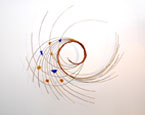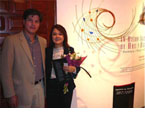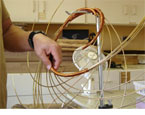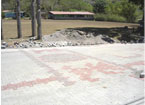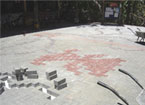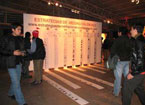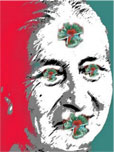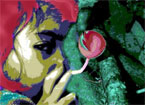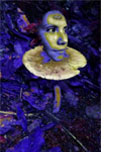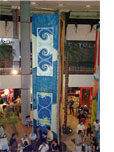|
|
|||||||||||||||||||
| home | history | exhibitions | projects | gallery | analysis | links | contact | blog | |||||||||||||||||||
|
|
 |
 |
|||||||||||||||||
|
PROJECTS
|
|||||||||||||||||||
|
Projects |
|
||||||||||||||||||
|
Work in progress for the Biennial Exhibition “Hombre + Mujer = Creación” In December 2005 Rosemary Golcher gets in contact with her friend and colleague, artist Alonso Durán, to present her idea about participating together at the Biennial Exhibition of Textiles. He immediately accepted. Both artists share several similarities; for example, for some years they have worked abstract art and have used lines as important elements in their pieces. Alonso Durán has been developing the spiral as the main theme of some of his works in acrylic painting and digital art; on her part, Rosemary Golcher uses interwoven lines in leadwork as the structure of her work, finished with water-colour and collage. They took some time to think over how they would develop the project. Meantime, Rosemary Golcher had been working on the “Hilando Textiles” series, mixed painting (water-colour, collage and leadwork), which she presented at the Sophia Wanamaker Gallery of the Centro Cultural Costarricense-Norteamericano (March 2006). |
||||||||||||||||||
|
Project |
|
||||||||||||||||||
|
Homage to the indigenous peoples of Costa Rica. Project of the paving stone road in Punta Islita This project is homage to the indigenous peoples who inhabited our country yesteryear and to those who live today in some mountains of Costa Rica. We Costa Ricans have inherited from our indigenous ancestors a great number of very valuable objects which have taught us about their customs, daily lives and socio-political organization. Most of these articles are in museums and unfortunately not everybody has the chance to visit them, and so it is not going overboard to tell a little of this legacy through this project. I named the road in front of the church, “Legados de Nuestros Indígenas,” and the one off the “pulpería” (small convenience store) to the daycare, “Orígen del Indígena.” The “Legado de Nuestros Indígenas” Road On this road that begins in front of the church and ends in front of the “pulpería,” I illustrate some of the objects the natives used in their daily lives, for example: metates (stone with a concave upper surface used in Latin America for grinding and pulping seeds, vegetables, etc.), ceramic and usable or decorative objects with diverse forms and their socio-political organization based on the “cacicazgo” (chieftainship). The Metate For the elaboration of the objects, the natives selected raw materials that were characteristically hard, beautiful and functional. The artisans who worked these objects had great dexterity for creating beautifully decorated objects filled with great symbolism, or else very simple objects. |
||||||||||||||||||
|
Project |
|
||||||||||||||||||
|
Project worked via the Internet Chilean Rosa Apablaza created the project, “Mediation Strategies on the Web” (Estrategias de Mediación en Red), and for the month of April of 2006, she contacted 18 visual artists, Rosemary Golcher among them, to ask for their participation in the project. The majority of them shared the particularity that they lived far away from one another, in countries like Chile, Canada, Spain, Argentina, Uruguay, Colombia, Guatemala, Mexico, France, Germany and Costa Rica. Rosa Apablaza came up with the idea that they worked in pairs, which she herself selected, and proposed that they worked for the whole month of May of 2006 on a free-theme project, incorporating all the information into a blog via the Internet. In this manner and wholly by the works of chance, Karín Vásquez from Chile and Rosemary Golcher from Costa Rica, not knowing each other and separated by many kilometres of distance, began to work. They titled their project, “Fusiones Americanas,” and immediately set themselves to work. They elaborated their project, based on their proposals in digital photography: Karín Vásquez with “Americanas”—In this selection of photographs entitled “Americanas,” I have been inspired by the rescue of the local woman, the women from the region where I live: the mountains and valleys, with the intention to capture a fragment of the reality of their daily and vital course . |
||||||||||||||||||
|
Project |
|
||||||||||||||||||
|
Place: Centro Comercial Multiplaza de Escazú In September 2003, the construction company RAE Ingenieros S.A., interested in supporting Costa Rican art, summoned 23 national artists so that each one would develop a giant format art work (1.56 m x 8m) on a vinyl structure. These works would serve as covers for the scaffolding in which the construction company´s labourers would work on the remodelling of one section of the Centro Comercial Multiplaza Escazú. This had the purpose of allowing visitors to appreciate works of art, instead of looking at steel. The 23 national artists´ canvases were inspired on free themes. |
||||||||||||||||||
